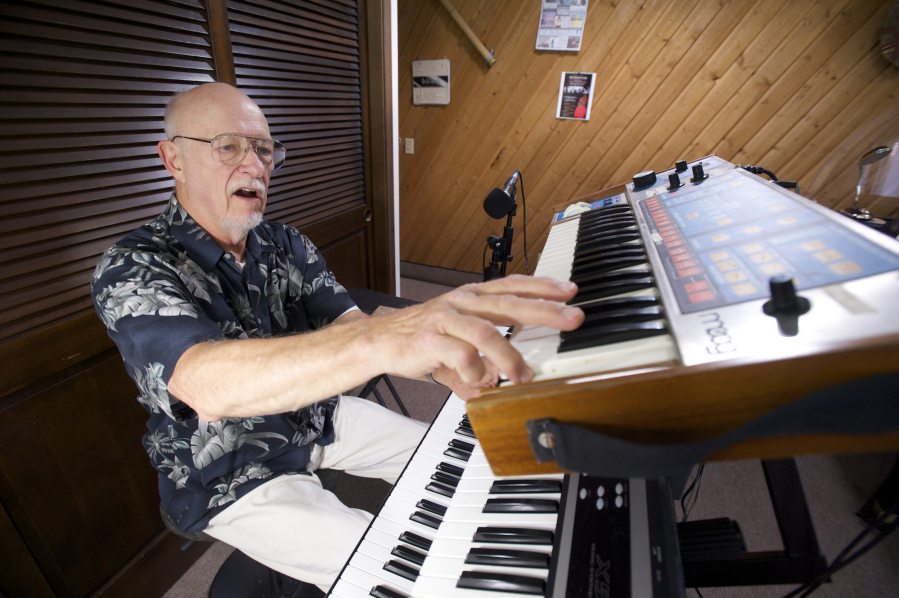About 10 days after Mount St. Helens erupted in May 1980, Jim Templeton came home to Spokane from his temporary residence in Denmark, where he was playing and teaching jazz piano.
Something strange was in the air. “All this dust was settling all around the Northwest,” he said. “People were collecting it in little bottles and jars.” Dust seemed to be the theme of that summer, he said. And not just any dust — miraculous dust that erupted from deep inside the planet. Volcanic dust. Call it cosmic dust.
That’s what Templeton called it after he met a hotshot guitarist named Myles Kennedy. The two of them started a stellar jazz-funk outfit that Templeton dubbed the Cosmic Dust Fusion Band. Heavily influenced by fusion masters Weather Report, the band that had a big hit with “Birdland” in 1977, Cosmic Dust had a good run of gigs and recordings through 2005, Templeton said. “It was a group of really great musicians,” he said.
Jazz fusion either has or hasn’t gone out of style, depending on how you look at things. Now that we have the Internet and the Cloud, isn’t everything always in style?
That’s how Templeton sees it. He moved to Vancouver in 2005 and started a different band. He also started a sideline offering craniosacral therapy and therapeutic massage at his home. And, for a few years, he owned and managed Ivories, a celebrated jazz club in Portland’s Pearl District. Musicians and fans alike loved the place, but hosting live music is always an iffy business, Templeton said, and he realized after a while that he couldn’t keep personally subsidizing it.
But it was a great and worthy experiment, Templeton said, and if he has any regrets it’s only that while he was playing club manager, he didn’t play much piano. He’s always wanted to “get the fusion thing going again,” he said — and now he has.
Landscapes and taxicabs
The “third edition” of the Cosmic Dust Fusion Band is ready to take the stage and hit the studio. “One of my main goals is to get my tunes that haven’t been recorded yet onto CD,” Templeton said. “And I just want to get this band back onto the scene.”
This latest version of Cosmic Dust will debut in a special Memorial Day afternoon concert at the Unitarian Universalist Church of Vancouver, 4505 E. 18th St. Tickets are $12 at the door or $10 in advance through Templeton’s website, http://jimivories.net.
Who are the players? Pete Petersen on winds and the uber-fusiony Electronic Wind Instrument; Sam Hallam on basses; Charles Neal, drums; and Mike Doolin on guitars. Plus Templeton himself on all his favorite keyboards and synthesizers — including the good ole monophonic Moog.
That’s the Frankenstein monster that first reared its head in the late 1960s; it’s “monophonic” because it generates one exceptionally pure, beautiful, electronic tone at a time, Templeton said. (Popular examples include the Beatles’ “Abbey Road” album, with sunshiny Moog lines dropped into songs like “Here Comes the Sun,” and many 1970s hits by Stevie Wonder.)
Other synthesizers manage the opposite: they can sound like violins, brasses, entire orchestras. “There’s a whole palate of possible colors to play with,” Templeton said.
Vistas of sound are Templeton’s goal. “What I like to create in my music is a landscape,” he said. “Something visual is going on in my head. It’s a three-dimensional thing.”
Many of those musical landscapes are sweeping, scenic, spacious — “cosmic,” in fact — like the mountains and prairies of Wyoming and Colorado that have inspired Templeton so much, he said. But he’s also been influenced by artificial landscapes. After he barely survived the city one crazy summer day, Templeton wrote a hectic, nervous piece called “New York Taxi Cab.”
“My God!” he remembers thinking. “These people, these roads!”




